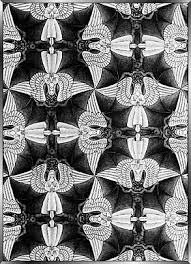Charles Allen Gilbert "All Is Vanity"
Old postcard
We believe that images depict the real world but they are no the real world. They are pigment on a surface that tricks our brain into seeing a face, a horse or a tree. Artists have played with the tricks that our eyes play on our minds from Optical Illusions to Animation.
Do you see both the old woman and the young woman? The old woman's mouth is the young woman's necklace. The old woman's nose is the young woman's chin. They share their hair, the scarf, the fur coat and the feather in their hair. This is a classic eye trick that has appeared in psychology books for years as a classic example of an optical illusion.How many legs does this elephant have?
M.C. Escher 'Rippled Surface' 1950
M.C. Esher has created the illusion of the rippling surface of water. He has carved into a surface, inked it up and taken a print from it. The raised areas of the surface have left a mark - creating the black ripple effect. There our elements of science and mathematics to Escher art and a fascination in optical illusions.
'Hand with Reflecting Sphere' M. C. Escher 1935
M C Escher
M C Escher
This image by M C Escher juxtaposes Bats and angels to create a continuous pattern. There is an element of playfulness to Escher's work.
Bridget Riley came to prominence in the 1960's during the Op Art movement. Riley counts Paul Klee amongst her influences and recently arranged a show at the Hayward Gallery. Her images create a dizzying optical effect and create the illusion of movement. All an image is, is pigment on a surface and these images by Riley a flat black lines on canvas. However, they seem to move, rotate and can not be look at too long. Riley used Rhythm and Repetition to create her work and knew that a simple line is transformed when repeated.
Barbara Brown 'Spiral' fabric design
Chrissie Shrimpton and Ossie Clark, 1965 by David Bailey
A modern Op Art influenced fashion shoot by Solve Sundsbo
Op Art bold use of stark black and white led to it be incorporated in 1960's popular culture. Op Arts influence can be seen in the work of fashion designers, advertising, magazine layouts and still has an influence today. Go here to find an Op Art Adobe illustrator tutorial.
Peter Keetman was a key member of fotoform (see the section on Otto Steinert here). These images show he use of pattern - whether he is photographing pipes or creating experimental abtract images.
As of 1948, Keetman experimented with abstract rhythmic images which he produced by swinging a flashlight over a camera with an open shutter placed on a rotating record player. The images recorded two dynamic movements yet produced a very harmonious pattern.





















